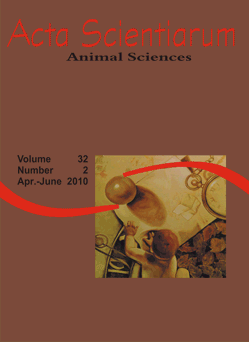<b>Transportation of curimbata <em>Prochilodus lineatus</em> juveniles in different densities</b> - doi: 10.4025/actascianimsci.v32i2.8415
Keywords:
Prochilodus, stress, hematology, metabolites, ions, water
Abstract
This study evaluated the effects of curimbata Prochilodus lineatus transportation in three densities (100, 150 and 250 g L-1) on survival, metabolic, ionic and hematological (red series) variables. Curimbata juveniles were transported in plastic bag during six hours, and sampled before packing, immediately after the arrival, 24 and 96 hours after transportation. During recovery, higher mortality was seen in fish transported in the highest density. Water variables, such as conductivity and total ammonia, presented increased values as density increased (p < 0.05), whereas the opposite occurred with dissolved oxygen. Glucose level observed in the arrival was high, significantly reducing after 96 hours. Among ionic variables, chloride decreased in higher fish densities and according to sampling times. Red series hematological variables, such as hematocrit, red blood cell and hemoglobin, increased in arrival, but diminished 96 hours after transportation. There were no significant differences in the interaction between density and time of sampling for mentioned variables. 250 g L-1 density induced the highest mortality rate and the worst variables values measured. 96 hours of recovery after the stressing event was enough to return to initial values for hematological variables, but was not sufficient to return to initial values for metabolic and ionic variables.Downloads
Download data is not yet available.
Published
2010-04-26
How to Cite
Gonçalves, A. F. N., Takahashi, L. S., Urbinati, E. C., Biller, J. D., & Fernandes, J. B. K. (2010). <b>Transportation of curimbata <em>Prochilodus lineatus</em> juveniles in different densities</b> - doi: 10.4025/actascianimsci.v32i2.8415. Acta Scientiarum. Animal Sciences, 32(2), 205-211. https://doi.org/10.4025/actascianimsci.v32i2.8415
Issue
Section
Nonruminant Nutrition
DECLARATION OF ORIGINALITY AND COPYRIGHTS
- I Declare that current article is original and has not been submitted for publication, in part or in whole, to any other national or international journal.
The copyrights belong exclusively to the authors. Published content is licensed under Creative Commons Attribution 4.0 (CC BY 4.0) guidelines, which allows sharing (copy and distribution of the material in any medium or format) and adaptation (remix, transform, and build upon the material) for any purpose, even commercially, under the terms of attribution.
Read this link for further information on how to use CC BY 4.0 properly.
0.9
2019CiteScore
29th percentile
Powered by 








































